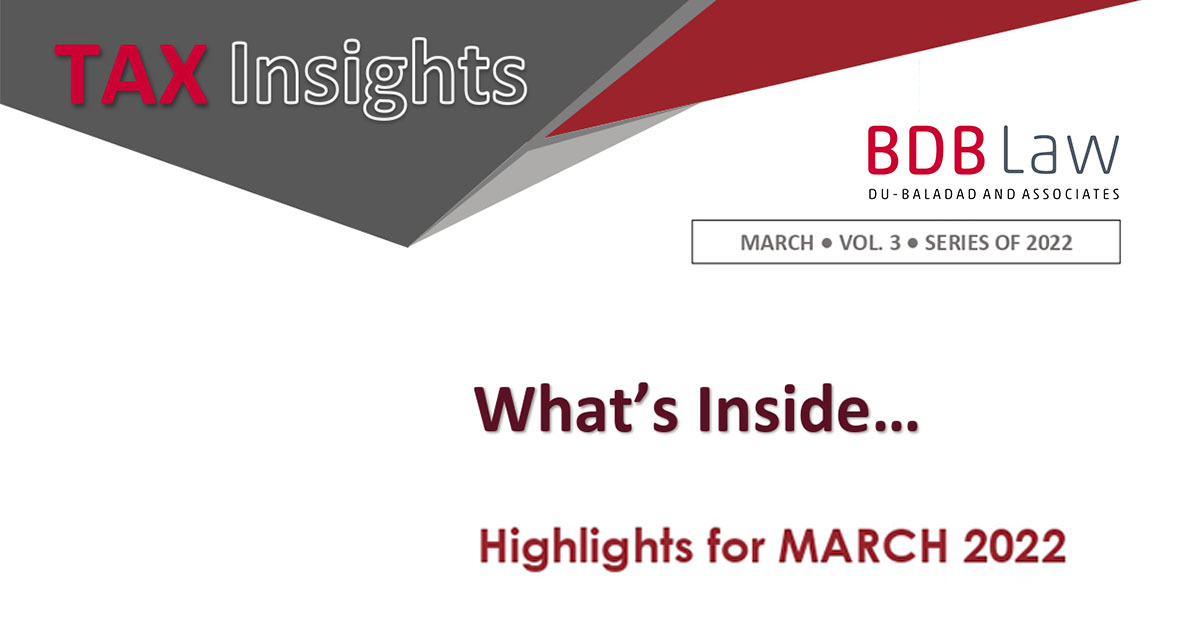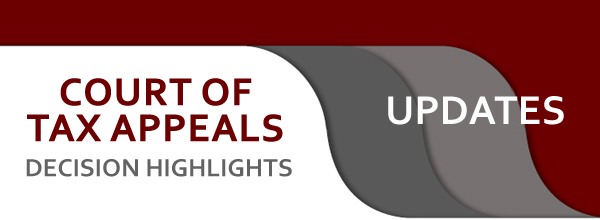


MARCH • VOL. 3• SERIES OF 2022
INSIGHTS is a monthly publication of BDB LAW to inform, update and provide perspectives to our clients and readers on significant tax-related court decisions and regulatory issuances (includes BIR, SEC, BSP, and various government agencies).

DISCLAIMER: The contents of this Insights are summaries of selected issuances from various government agencies, Court decisions, and articles written by our experts. They are intended for guidance only and as such should not be regarded as a substitute for professional advice.
Copyright © 2022 by Du-Baladad and Associates (BDB Law). All rights reserved. No part of this issue covered by this copyright may be produced and/or used in any form or by any means – graphic, electronic, and mechanical without the written permission of the publisher.
What's Inside ...
- HIGHLIGHTS FOR MARCH 2022
- SIGNIFICANT COURT DECISIONS
- Court of Tax Appeals
- SIGNIFICANT REGULATORY ISSUANCES
- Bureau of Internal Revenue
- Securities and Exchange Commission
- Bangko Sentral Ng Pilipinas
- Insurance Commission
- PUBLISHED ARTICLE
- Cross-Border Doctrine is Dead
- OUR EXPERTS
- The Personalities
- The Personalities


HIGHLIGHTS for MARCH 2022
COURT OF TAX APPEALS DECISIONS
- The security guard, in all cases, is considered an authorized person to receive the LOA for purposes of determining valid service. (Commissioner of Internal Revenue v. AC Corp., CTA EB Case No. 2279 [CTA Case No. 8485], February 28, 2022)
- CTA has jurisdiction to pass upon the constitutionality or validity of a tax law or regulation when raised by the taxpayer as a defense in disputing or contesting an assessment or claiming a refund. (San Miguel Brewery vs. Commissioner of Internal Revenue, CTA EB NOS. 2320 & 2327, February 21, 2022)
- It is now within the power of the CTA, through its power of certiorari, to rule on the validity of a particular administrative rule or regulation so long as it is within its appellate jurisdiction. (Commissioner of Internal Revenue vs. San Miguel Brewery, Inc., CTA EB No. 2283 [CTA Case No. 9743], February 10, 2022)
- Absent any proof of authority of the person who initiated a Petition for Review on behalf of an LGU, the said Petition for Review shall be dismissed outright. (Danilo Mendez vs. Central Board of Assessment Appeals, CTA EB No. 2265 [CBAA Case No. V-37] [LBAA Case No. 2013-001], February 9, 2022)
- As provided for by RMO No. 19-2007, CIR-imposed compromised penalties shall be itemized in a separate assessment notice/demand letter; a compromise offer must be written either in the form of Annex B, otherwise, it must be signed by both taxpayer and the CIR. (Commissioner of Internal Revenue vs Dunlevy Food Corporation, CTA EB No. 2294, February 08, 2022)
BIR ISSUANCES
-
RMC No. 19-2022, February 4, 2022 – This provides clarification and guidance on Section 8 of Revenue Regulations No. 5-2021 on the tax-free exchanges of properties.
-
RMC No. 20-2022, February 17, 2022 – This prescribes guidance on the filing of Requests for Confirmation (RFC), Tax Treaty Relief Applications (TTRAs) and Tax Sparing Applications.
-
RMC No. 21-2022, February 21, 2022 – It prescribes the guidelines in the claim of Input Value-Added Tax (VAT) on purchases or importations of capital goods, pursuant to Section 110 of the National Internal Revenue Code of 1997 (Tax Code), as amended by Republic Act No. 10963 (TRAIN Law).
-
RMC No. 22,2022, February 21, 2022 – It provides Tax Compliance Reminders for the May 9, 2022 National and Local Elections.
SEC ISSUANCES
- SEC MC- NO-2-s-2022-007, February 8, 2022 – This provides that the Schedules for Filing of Annual Financial Statements and General Information Sheet
BSP ISSUANCES
-
BSP M-2022-007, February 2, 2022 – This provides that it prescribes the FAQs on Targeted Financial Sanctions (TFS)
IC ISSUANCES
-
IC CL-2022-05, February 5, 2022 – This provides that it prescribes the Dissemination of the National AML/CFT Coordinating Committee (NACC) Statement on the Impact of Grey-Listing
-
CL-2022-06, February 14, 2022 – This prescribes the reference for Valuation of Publicly Listed Equities and the Foreign Currencies Exchange Rates as of Year-End 2021
-
CL-2022-07, February 16, 2022 – This prescribes the Online Quarterly Submission of Reports on Negative List of Officers and Employees for Pre-Need Companies and Health Maintenance Organizations.
-
CL-2022-08, February 21, 2022 – This prescribes Guidelines on the Implementation of Republic Act No. 11523 or the "Financial Institutions Strategic Transfer (FIST) Act”


Issuing LOAs is a delegable power which the CIR may devolve to Revenue Regional Directors, Assistant Commissioners/Head Revenue Executive Assistants.
The taxpayer was held liable for deficiency income tax, VAT, EWT, WTC, and DST for TY 2013. It filed a protest and subsequently filed a petition before the CTA Division arguing that the Revenue Officer (RO) and Group Supervisor (GS) do not have authority to conduct an audit/investigation. The CTA granted the petition. The case involves two (2) Memorandum of Agreement (MOA). The first MOA was issued on April 19, 2016 and the second on June 17, 2016. The second MOA referring to the newly assigned RO and GS to replace the previously assigned RO.
The Court En Banc, in upholding the ruling of the Court in Division, cited Section 10 of the NIRC of 1997, as amended, which states that issuing LOAs is a delegable power which the CIR may devolve to Revenue Regional Directors. Accordingly, the ROs who conducted the examination of the respondent’s records may be deemed authorized to do so without the need for a new LOA, if said letter or notice or memorandum was signed by persons duly authorized. Under RMO No. 29-07, the equivalent of a Regional Director in the Large Taxpayers Service is the Assistant Commissioner/Head Revenue Executive Assistant. Here, the MOA was signed by a Revenue District Officer, who has no power to authorize the examination of taxpayer’s accounts. Thus, the authorities of the ROs are void and the subject deficiency tax assessments bear no valid fruit. (Commissioner on Internal Revenue vs. Global Energy Supply Corporation, CTA EB No. 2365 [CTA Case No. 9673], February 28, 2022)
The security guard, in all cases, is considered an authorized person to receive the LOA for purposes of determining valid service.
A taxpayer questions the validity of an LOA issued by the BIR because it was received by an unauthorized person, i.e., the security guard, thus the same is not legally binding. The CIR countered citing the case of Landbank vs. Heirs of Fernando Alsua where the Supreme Court ruled that receipt by a security guard is deemed a receipt by a party's counsel as well. The BIR insists that the security guard had the proper authority to receive official notices such as the LOA, hence, his receipt of the LOA was well within the thirty (30)-day period provided under Revenue Audit Memorandum Order (RAMO) No. 1-00.
The Court En Banc agrees with the BIR. The Court ruled that the security guard, in all cases, is considered an authorized person to receive the LOA for purposes of determining valid service. Clearly, the security guard whose signature appears in the photocopy of LOA-00048613 (as having received it on July 29, 2008) is no stranger to the taxpayer. Security guards are not usually hired as employees of the company but are employed by private security agencies who then assign them to various companies under a contractual arrangement. (Commissioner of Internal Revenue v. AC Corp., CTA EB Case No. 2279 [CTA Case No. 8485], February 28, 2022)
The Court of Tax Appeals may consider evidence attached to the motion for reconsideration.
Taxpayer claims for refund for input taxes over its sales to “Microchip Technology Ireland” formerly registered as “ULC-Private Unlimited Company.” In opposition, the BIR contends that it failed to present the SEC Certificate of Non-Registration which establishes that the customer is a non-resident foreign corporation. The Court in Division then denied the claim for refund and held that since it did not have the requisite certificate, the sales to it cannot qualify for VAT zero-rating purposes.
The taxpayer subsequently filed a motion for reconsideration attaching the SEC Certification indicating that MTI is a foreign corporation. In its amended decision, the Court in Division held that the sales to “Microchip Technology Ireland” qualify for VAT zero-rating allowing then the claim for a refund subject to re-computation of the refundable amount. It ruled that proceedings before the Court of Tax Appeals are not governed strictly by technical rules of evidence. The paramount consideration remains the ascertainment of truth. Settled in jurisprudence is that the CTA may consider evidence attached to the motion for reconsideration and that procedural rules should not bar courts from considering undisputed facts to arrive at a just determination of a controversy. (MTI Advanced Test Development Corporation vs. Commissioner of Internal Revenue, CTA Case No. 9690, February 24, 2022)
Proof of actual remittance is not a condition to claim for a refund of unutilized tax credits.
The BIR, in filing its motion for reconsideration, contravenes the Court’s ruling and asserts that the taxpayer is not entitled to a partial grant of refund of alleged excess CWT for TY 2014 based on the facts that the taxpayer failed to: (1) provide supporting documents; (2) submit the required documents in accordance with the list provided under Revenue Memorandum Order (RMO) No. 53-98; and (3) prove actual remittance of the alleged excess taxes.
The Court in Division, in denying the motion, cited the case of CIR vs. Univation Motor Philippines, Inc. where the Court ruled that the CTA is not limited by the evidence presented in the administrative claim in the BIR. The claimant may present new and additional evidence to the CTA to support its case for tax refund. As regards the proof of actual remittance, the Court held that proof of actual remittance is not a condition to claim for a refund of unutilized tax credits. It is the payor-withholding agent, and not the payee-refund claimant, who is vested with the responsibility of withholding and remitting income taxes. Lastly, on the non-submission of documents under RMO 53-98 and RR No. 2-2006, the Court held that it is not fatal to the taxpayer’s claim but merely imposes a penalty of a fine. (Tullet Prebon [Philippines], Inc. vs. Commissioner of Internal Revenue, CTA Case No. 9562, February 24, 2022)
A LOA signed by at least a Regional Director (RD) is essential to confer authority to an RO and GS to continue audit; the RD has no authority to ratify an act which is void ab initio.
In seeking for the reversal of the Court in Division’s ruling, the BIR maintains that the authority of RO Ifurung and GS Sy from the same LOA were ratified by the Regional Director (RD) who issued the LOA and that the Court cannot grant a relief that was never prayed for by the taxpayer. The Court, in its previous ruling, held that such LOA was void, consequently, the RO and GS had no authority to conduct an audit/investigation. Hence, the filing of the motion for reconsideration.
The Court in Division, in resolving such motion, addressed the issue of ratification by the RD of the actions of RO and GS when the RD issued the PAN and FAN. The Court said that ratification cannot validate an act void ab initio done absolutely without authority, thus, the RD cannot ratify the findings of the RO and GS by issuing the PAN and FAN since his failure to issue a new LOA renders the assessment void ab initio. On granting a relief not prayed for, the Court held that the CTA, as a court of justice, has jurisdiction to decide the issue on the lack of authority of RO and GS to continue the audit and examination, albeit the same was not raised in the protest letter to the FAN and in the Petition for Review. (Casas + Architects vs. Commissioner of Internal Revenue, CTA Case No. 9960, February 24, 2022)
Once receipt is denied, the CIR must prove through a preponderance of evidence that the assessment notices were indeed received by the taxpayer.
The taxpayer is assailing the validity of the deficiency assessment issued by the BIR as it is void for lack of a valid LOA. The taxpayer also denies the receipt of PAN. The CTA Division found that the assessment is void for lack of authority of the revenue officer who audited taxpayer.
The CTA En Banc ruled that once receipt is denied, the CIR must prove through a preponderance of evidence that the assessment notices were indeed received by the taxpayer. In the present case, the taxpayer has unequivocally denied receipt of the PAN. Accordingly, the burden to prove that the PAN was received by taxpayer is shifted to the CIR. The CIR failed to provide convincing proof that the PAN was received by the taxpayer. The receiving signature of the registry return receipt card for the PAN is blank. Consequently, there is no evidence that the PAN was actually received by the taxpayer or its authorized representative. Failure to prove that the PAN was indeed received by the the taxpayer renders the instant assessment null and void. Without proof of receipt, the PAN is deemed not received by the taxpayer. Hence, the taxpayer’s right to be informed of the assessments issued against it has been violated. (Commissioner of Internal Revenue vs. Jopauen Realty Corporation, CTA E8 NO. 2206 (CTA Case No. 8943), February 21, 2022)
CTA has jurisdiction to pass upon the constitutionality or validity of a tax law or regulation when raised by the taxpayer as a defense in disputing or contesting an assessment or claiming a refund.
The instant case pertains to a claim for refund representing excise taxes collected by the BIR on San Mig Light for the period covering January 1, 2014 to December 31,2014. The CIR assails the jurisdiction of the Court over the case. According to him, the taxpayer primarily seeks to nullify a provision of RMC No. 90-2012 and the alleged action for refund of erroneously collected excise taxes is merely consequential thereto. Absent the nullification of RMC No. 90-2012, the taxpayer’s cause of action has no leg to stand on. However, the authority to declare void an administrative issuance rest upon courts of general jurisdiction and not on courts of special jurisdiction such as the Court of Tax Appeals (CTA).
The CTA En Banc ruled that the CTA has undoubted jurisdiction to pass upon the constitutionality or validity of a tax law or regulation when raised by the taxpayer as a defense in disputing or contesting an assessment or claiming a refund. It is only in the lawful exercise of its power to pass upon all matters brought before it, as sanctioned by Section 7 of Republic Act No. 1125, as amended. The CTA may likewise take cognizance of cases directly challenging the constitutionality or validity of a tax Jaw or regulation or administrative issuance (revenue orders, revenue memorandum circulars, rulings). Section 7 of Republic Act No. 1125, as amended, is explicit that, except for local taxes, appeals from the decisions of quasi-judicial agencies on tax-related problems must be brought exclusively to the Court of Tax Appeals. (San Miguel Brewery vs. Commissioner of Internal Revenue, CTA EB NOS. 2320 & 2327, February 21, 2022)
The failure of the CIR to render a decision on the taxpayer's administrative claim for refund, within the 120-day period, is deemed a denial of its claim. Hence, a taxpayer should no longer wait for CIR to come up with a decision before it files a judicial claim before the Court in Division.
The CTA En Banc ruled that one of the conditions for a successful judicial claim or refund or credit under the VAT system is compliance with the 120+30 day mandatory and jurisdictional periods. Accordingly, the failure of the CIR to render a decision/ruling on the taxpayer's administrative claim for refund, within the 120-day period, is deemed a denial of its claim and should aptly be treated by the taxpayer as such. Hence, a taxpayer should no longer wait for CIR to come up with a decision before it files a judicial claim before the Court in Division.
In this case, the taxpayer filed its administrative claim on March 14, 2013. Following the pronouncement in the Pilipinas Total Gas, Inc. case, taxpayer had thirty (30) days, or until April 13, 2013, within which to submit its documentary requirements, if any. Accordingly, CIR had one hundred twenty (120) days from April 13, 2013 or until August 11, 2013, within which to render a decision on the said claim. However, in this case, the 120-day period lapsed without a decision or ruling from the CIR. Thus, the taxpayer had thirty (30) days, or until September 10, 2013, within which to file its judicial claim before the CTA. Here, the Petition for Review was filed on October 30, 2018, thus, filed out of time. (Lapanday Corporation vs. Commissioner of Internal Revenue, CTA EB No. 2360 (CTA Case No. 9966), February 21, 2022)
For the instant claim for refund to prosper, the taxpayer must not only establish that it has timely filed its refund claim, it must likewise prove that the subject FWTs paid fall under the definition of "erroneous or illegal tax".
The taxpayer argues that it has erroneously paid the FWT corresponding to dividends declared in excess of the unrestricted retained earnings.
The CTA stated that the NIRC allows the recovery of taxes erroneously or illegally collected. An "erroneous or illegal tax" is defined as one levied without statutory authority, or upon property not subject to taxation, or by some officer having no authority to levy the tax, or one which is some other similar aspect is illegal. Thus, for the instant claim for refund to prosper, the taxpayer must not only establish that it has timely filed its refund claim, it must likewise prove that the subject FWTs paid fall under the above-stated definition of "erroneous or illegal tax".
It must be pointed out that any error committed by the taxpayer in the determination of the appropriate tax base, or specifically, the total amount of dividends to be, or have been, distributed to its shareholders, does not automatically translate or result in an "erroneous or illegal tax'; as jurisprudentially defined. Surely, the taxpayer must still further prove that the collected or paid FWTs are indeed erroneous or illegal. (Matex International Inc. vs. Commissioner of Internal Revenue, CTA case No. 10180, February 15, 2022)
The “other matters” clause in Section 7(1) of RA No. 1125 does not give the Court an unbridled authority to rule on every matter perceivably related to a tax issue no matter how remote.
While the taxpayer admits that the tax assessment has long become final, the taxpayer contends that the issues raised in the MR can still be ruled upon by the Court as they fall within the purview of Section 7(1) of RA No. 1125. Said section provides for the exclusive appellate jurisdiction of the Court to review by appeal decisions of the CIR on other matters arising under the NIRC or other law or part of law administered by the BIR.
The Court denied the MR ruling that the “other matters” clause does not give the Court an unbridled authority to rule on every matter perceivably related to a tax issue no matter how remote. Moreover, the clause does not give the Court power to reopen assessments that have already attained finality. Such an isolated interpretation of Section 7 of RA No. 1125 runs afoul to the well-established principles of prescription and limitations of jurisdiction. Prescription in our legal system serves a valuable purpose. It is by no means some arbitrary deadline imposed for mere convenience. (Ernesto Tamparong, Jr. vs. Commissioner of Internal Revenue, CTA Case No. 9520, February 17, 2022)
Under the LGC, the non-payment of the assessed tax does not render the protest
invalid.
The City of Makati assessed the taxpayer deficiency taxes, which the taxpayer protested within the 60-day period without, however, paying the assessment under protest. The City of Makati argues that the protest to the assessment is not valid for failure to pay the tax assessed under protest as required by Section 7B.14(c) of the Revised Makati Revenue Code (“RMRC”).
In ruling in favor of the taxpayer, the Court found that, under Section 195 of the LGC, there is no requirement that payment should have been made by the taxpayer in order to validly protest the assessed tax. Notably, it is only required that the protest be done within a period of 60 days from receipt of the notice of assessment; otherwise, the assessment becomes conclusive and unappealable.
The Court likewise ruled that ordinances should not contravene existing statutes enacted by Congress, such as the LGC. Section 7B.14(c) requires the taxpayer to first pay the assessed tax; otherwise, the protest shall not be entertained. However, such requirement is not present under Section 195 of the LGC for the protest to be given due course. Thus, Section 7B.14( c) of the RMRC must be set aside. (City of Makati vs. DMCI Holdings, Inc., CTA AC No. 234, February 10, 2022)
It is now within the power of the CTA, through its power of certiorari, to rule on the validity of a particular administrative rule or regulation so long as it is within its appellate jurisdiction.
The taxpayer filed with the BIR and the CTA a claim for a refund representing overpayment of excise taxes erroneously assessed and collected. The CTA in Division rejected part of the claim for failure to present a requirement under a Revenue Memorandum Circular (“RMC”). Included in the Petition for Review of the taxpayer is the prayer for nullification of the pertinent RMC.
The CIR alleges that the taxpayer’s ultimate prayer in its petition with the Court in Division is to seek the nullification of the RMC, the action for refund of taxes being merely inconsequential. Thus, the jurisdiction should be with the regular courts and not with the CTA.
The CTA ruled that it has undoubted jurisdiction to pass upon the constitutionality or validity of a tax law or regulation when raised by the taxpayer as a defense in disputing or contesting an assessment or claiming a refund. It is now within the power of the CTA, through its power of certiorari, to rule on the validity of a particular administrative rule or regulation so long as it is within its appellate jurisdiction. (Commissioner of Internal Revenue vs. San Miguel Brewery, Inc., CTA EB No. 2283 [CTA Case No. 9743], February 10, 2022)
Absent any proof of authority of the person who initiated a Petition for Review on behalf of an LGU, the said Petition for Review shall be dismissed outright.
In its Motion to Dismiss, the taxpayer alleges that the Provincial Treasurer lacks the authority to represent the Province of Negros Oriental in filing the Petition for Review and to execute the Certification against Non-Forum Shopping. This is evidenced by the Provincial Treasurer’s continuous failure to abide with the Court’s orders.
In dismissing the Petition for Review, the Court ruled that absent any proof of authority of the person who initiated a Petition for Review on behalf of an LGU, the said Petition for Review shall be dismissed outright. While the LGC grants certain powers and duties to the local treasurer, a careful examination of the said law would reveal that there is nothing therein which authorizes the said official from filing an appeal in the appropriate court on behalf of the concerned LGU. Considering that in this case, the Provincial Treasurer and Municipal Treasurer have continuously failed to submit any proof that the persons who initiated the Petition and signed the Verification and Certification against Non-Forum Shopping were duly authorized to do so, the instant Petition should be dismissed outright. (Danilo Mendez vs. Central Board of Assessment Appeals, CTA EB No. 2265 [CBAA Case No. V-37] [LBAA Case No. 2013-001], February 9, 2022)
A Referral Memorandum is equivalent to an LOA where the RO named in the original LOA will just continue the audit/investigation without the other ROs named in the original LOA.
The CIR issued a LOA for the audit/investigation of the taxpayer’s books of accounts. The LOA named 6 Revenue Officers (“ROs”), including RO Allan Maniego. Subsequently, a Memorandum of Assignment (“MOA”) was issued referring to the continuation of the audit/ investigation to RO Allan Maniego. In assailing the assessment, the taxpayer asserts that a MOA cannot be treated as an LOA, because a reassignment necessitates the issuance of a new LOA.
The Court ruled that the taxpayer’s argument that a Referral Memorandum is not equivalent to an LOA is not applicable because there was no substitution of ROs but a mere reduction of ROs to only 1, i.e., RO Allan Maniego. A Referral Memorandum is not equivalent to an LOA when such will refer the continuance of the audit/ investigation to a new set of ROs. It does not refer to a situation where the RO named in the original LOA will just continue the audit/ investigation without the other ROs named in the original LOA.
The Court found that included in the MOA is a statement that the MOA serves as a "continuation of the audit/investigation to replace the previously assigned ROs who resigned/retired/transferred to another district office." The Court believes that the authority of RO Allan Maniego emanates from the original LOA, hence amply clothes him with the requisite authority to continue the audit/investigation of the taxpayer’s books without the other original ROs who presumably have been transferred/reassigned, resigned or retired. The authority of RO Allan Maniego under the subject LOA prevails under the subsequent MOA, hence, did not affect the validity of the assessments. (Commissioner of Internal Revenue vs. Market Strategic Firm, Inc., CTA EB No. 2281 [CTA Case No. 9280, February 9, 2022)
A Tax Verification Notice (“TVN”) is NOT equivalent to a Letter of Authority (“LOA”) which will serve as authority to conduct tax examination.
The taxpayer assailed through the CTA Division the validity of the TVN issued by BIR authorizing the assessment of the taxpayer’s alleged internal revenue tax liabilities for the taxable year/period 2008. The Court in Division granted the taxpayer’s petition and set aside the FDDA treating the TVN as not equivalent to LOA. The BIR moved for the reconsideration of the Division’s decision which was eventually denied. Aggrieved, the BIR appealed to the En Banc insisting that the TVN is equivalent to LOA and that there is no law prohibiting the BIR as well as its Regional Directors to delegate the issuance of TVN to the Revenue District Officer.
On appeal, the CTA En Banc affirmed the decision of the CTA Division and held that the delegated authority of the BIR must be pursuant to the issuance of an LOA and that there was no other equivalent notice as to such authority that was provided for by law that may substitute other than required LOA. Thus, a TVN which was nowhere mentioned in the 1997 NIRC, as amended, is not an LOA that vested authority to the Revenue Officer to conduct tax examination into the financial records of a taxpayer. Consequently, the lack of the required LOA shall invalidate the tax examination itself as well as the notices issued after such examination “for it is well settled that a void assessment bears no fruit.” (Commissioner of Internal Revenue vs. Jinzai Experts, Inc., CTA EB No. 2259, February 09, 2022)
Both the PAN and FAN must be issued by the Revenue Region having jurisdiction over the new business address, otherwise, the assessment shall be rendered void for want of valid authority.
On September 03, 2013, the taxpayer received an LOA from Revenue Region No. 8 for the conduct of an assessment of VAT deficiency for the period of January 01 to June 30, 2013. The assessment ensued with the PAN and FAN issued on October 28 and December 22, 2015, respectively. Thereafter, the taxpayer filed its administrative protest to the assessment contained in the FAN. Alleging inaction of the BIR, it sought judicial relief for the cancellation of the deficiency VAT assessment issued by RR No. 8-Makati, propounding that it was issued without valid authority as the taxpayer was already within the jurisdiction of RR No. 6 as it transferred its business address and registration to RR No. 6-Manila on 29 January 2015. The CTA Division, thereafter, granted the petition and found the assessment void.
The Court En Banc upheld the ruling of the CTA division. Records show that a new BIR Certificate of Registration was issued to the taxpayer by RDO Manila and it presupposes that it followed the procedures mandated by Section 236 (D) of the 1997 NIRC, as amended. The LOA issued by the RR No. 8-Makati could not be given effect to the petitioner as of the date of the taxpayer’s transfer of registration to RDO No. 29 since this RDO is beyond the jurisdiction of RR No. 8- Makati. Consequently, no valid authority to examine the taxpayer exists when the subject FAN was issued against, and received by the taxpayer. Not having the authority to examine the taxpayer in the first place, the assessment issued by RR No. 8-Makati is inescapably void. (Commissioner of Internal Revenue vs. Costner Trading Corporation, CTA EB No. 2322, February 09, 2022)
As provided for by RMO No. 19-2007, CIR-imposed compromised penalties shall be itemized in a separate assessment notice/demand letter; a compromise offer must be written either in the form of Annex B, otherwise, it must be signed by both taxpayer and the CIR.
The taxpayer pursued a judicial action claiming tax credits/refunds against paid CIR-imposed compromise penalties for alleged violations of the NIRC and/or tax regulations. Before the CTA Division, the CIR argued the lack of the court’s jurisdiction over the petition as the same does not contain any allegation that the amount paid by the taxpayer was erroneously or illegally assessed or collected, and hence, the taxpayer is not entitled to a refund. After the trial and pieces of evidence were considered, the CTA Division granted the taxpayer’s petition for review and ordered CIR to refund or issue a tax credit certificate in favor of the taxpayer. The CTA Division denied the subsequent motion for reconsideration filed by the CIR. Hence, an appeal was elevated before the CTA En Banc.
The CTA En Banc affirmed the CTA Division’s ruling. It held that the wording of Section 7(a)(1) of RA 1125, as amended, clearly and simply states that the exclusive appellate jurisdiction of the CTA includes the CIR’s decisions and inactions in cases involving, inter alia, refunds of penalties in relation to taxes. It went on and said that what is sought to be refunded in the case are compromise penalties, collected by, or imposed by the BIR, for supposed violations committed by the taxpayer and invoked Section 229 of the NIRC dealing with a refund of “any penalty claimed to have been collected without authority.” It emphasized that the CIR failed to adhere to the provisions of RMO No. 19-2007 as records show a dearth of evidence not only as regards the separate assessment notice, but also as to the required taxpayer’s written offer. (Commissioner of Internal Revenue vs Dunlevy Food Corporation, CTA EB No. 2294, February 08, 2022)
If the protest is denied, in whole or in part, by the Commissioner's duly authorized representative, the taxpayer may either: (i) appeal to the CTA or (ii) elevate his protest through a request for reconsideration to the Commissioner.
The taxpayer was assessed by the BIR and received an FNBS allegedly signed by an authorized officer of Revenue Region (“RR”) No. 7. Consequently, it filed an MR addressed against the Director of the same RR. The assessment was subsequently elevated through a petition for review which, however, was dismissed by the CTA Division. Aggrieved, the taxpayer filed an MR.
The CTA Division denied and affirmed its previous ruling. RR No. 12-99, as amended by RR 18-2013 provides that if the protest is denied, in whole or in part, by the Commissioner's duly authorized representative, the taxpayer may either: (i) appeal to the CTA within thirty (30) days from date of receipt of the said decision, or (ii) elevate his protest through a request for reconsideration to the Commissioner within 30 days from date of receipt of the said decision. In the instant case, the taxpayer addressed its MR on the FDDA to the RR No. 7’s authorized officer and not the CIR. By failing to avail of the aforementioned available remedies, the assessment consequently became final, executory, and demandable. From the foregoing, it is clear that the CTA no longer has jurisdiction to review the subject FFDA. (Masagana Management Services Corporation vs. Commissioner of Internal Revenue, CTA Case No. 10071, February 07, 2022)
It is not unlawful for an MOA to be issued instead of an LOA for the continuance of an audit as long as said MOA is issued and signed by the proper official which may be the Regional Director or the Assistant Commissioner/Head Revenue Executive Assistant in the Large Taxpayers Service.
The taxpayer was assessed for various tax deficiencies by virtue of an LOA issued by the CIR authorizing several ROs and GS. It was later re-assigned to other RO and GS pursuant to a Memorandum of Assignment (MOA) issued by the OIC-Chief for LT Audit Division. Assessment ensued and FAN/FLDD was issued. Arguing that the MOA did not validly clothe the several ROs the requisite authority to continue and finish the audit examination, the taxpayer filed an administrative and judicial protest seeking to nullify the FAN/FLDD. The CTA in Division ruled in favor of the taxpayer and declared the cancellation of the FAN/FLDD. Aggrieved, the CIR filed an MR which the CTA Division subsequently denied, thus, subsequently appealed to the CTA En Banc.
The CTA En Banc affirmed the CTA Division’s ruling declaring the FAN/FLDD void. It emphasized that unless authorized by the CIR or his duly authorized representative, through an LOA, an examination of the taxpayer cannot ordinarily be undertaken. As a rule, the power to issue LOAs may be delegated to RR Director. Relative thereto, under RMO 29-07 the equivalent of RR Director is the Assistant Commissioner/Head Revenue EA.
The CTA En Banc went further declaring that an MOA may have the same effect as an LOA provided it fulfills the following requirements inherent to the latter: (1) the grant of authority be done in writing and (2) although the document may not be entitled “LOA” but otherwise, it should contain all the elements necessary to establish a contract of agency between the CIR and new RO. In this case, the MOA is not issued by an authorized CIR representative, and the CIR is enjoined from collecting the assessed deficiency taxes. It should have secured a new LOA. (Commissioner of Internal Revenue vs First Philippine Power Systems, Inc., CTA ETB No. 2243, February 03, 2022; Commissioner of Internal Revenue and First Life Financial Co., Inc, CTA EB No. 2263, February 03, 2022)
To qualify the sales made to a BOI-registered buyer as zero-rated sales, it must be shown through BOI certification that it actually exported its entire product during the period when the sales were made.
The taxpayer challenged the decision of the CTA Division disallowing tax refund for VAT zero-rating of its sales to BOI-registered buyers on the ground that the validity period of the BOI Certification is outside the subject period of the claim. The taxpayer argued that what is controlling for purposes of qualifying the sales as zero-rated sales is the period of coverage or the BOI Certification attesting to the period when the BOI-registered buyers actually exported their sales.
The CTA En Banc agreed with the taxpayer adopting the pronouncement of the Supreme Court in the 2020 Filminera case that without BOI certification that the products sold to BOI-registered buyers were actually exported and consumed in a foreign country, the sales cannot be considered export sales. (Orica Philippines, Inc. vs Commissioner of Internal Revenue, CTA EB No. 2367, February 03, 2022)
While assessment is not necessary before the civil liability of the taxpayer may be imposed, it is still incumbent upon the CIR to provide competent evidence on which the amount of such civil liability may be based.
A Joint Complaint Affidavit (“JCA”) of Revenue Officers showing the estimated deficiency VAT liability of the taxpayer was filed by the CIR. After trial, the taxpayer was convicted of violation of Sec. 255 of the NIRC but was absolved of civil liabilities as the CIR failed to present any evidence that an assessment has been issued by the CIR. The CIR filed a Motion for Partial Reconsideration (“MPR”), attaching therein the photocopies of the PAN and the FLD, which were not previously offered as evidence. The Court in Division denied the MPR. In its Petition for Review, the CIR claims that in case of no return or false or fraudulent returns, the tax may be collected in court without an assessment. The CIR also argues that the JCA nevertheless contains the computations which the Court in Division should have used as the basis for taxpayer’s civil liabilities.
The Court En Banc denied the Petition, ruling that while assessment is not necessary before the civil liability of the taxpayer may be imposed, it is still incumbent upon the CIR to provide competent evidence on which the amount of such civil liability may be based. Here, the computations in the JCA are not sufficient to fix with definiteness the civil liabilities of the taxpayer as such computations are mere estimates. The PAN and FLD, aside from being mere photocopies, were also not offered as evidence for the CIR.
While it is true that the Court in Division had found the taxpayer guilty beyond reasonable doubt in the criminal cases against her, still, the absence of a precise computation ties the hands of the Court En Banc and prevents it from decreeing the resulting civil liabilities. (People of the Philippines vs. Rebecca S. Tiotangco, CTA EB Crim. No. 080 [CTA Crim. Case Nos. O-599, O-601, O-603, and O-604], February 3, 2022)


RMC No. 19-2022,
February 4, 2022
It provides clarification and guidance on Section 8 of Revenue Regulations No. 5-2021 on the tax-free exchanges of properties.
This provides clarification and guidance to the RDO, other internal revenue officers and others concerned on Section 8 of RR No. 5-2021, particularly on the mandate to issue CAR sans a prior BIR confirmation or tax ruling on the tax-free exchanges of properties, while at the same time ensuring that the proper taxes due the Government on their subsequent sale or disposition are protected and collected thru the establishment and proper monitoring of their correct substituted basis.
- COVERAGE – Under Section 40(C)(2) of the 1997 Tax Code, as amended by CREATE, transactions are covered by the tax-free exchanges of properties are Re-organization and Transfer to a Controlled Corporation
- DETERMINATION OF SUBSTITUTED BASIS – Under Section 40(C)(5) of the Tax Code, as amended, the substituted basis of the properties transferred shall be determined as follows:
| A. Stock or Securities |
|
| B. Property in the Hands of the Transferee |
|
| C. Original Basis |
|
The substituted basis, as determined above shall be the basis for determining gain or loss on a subsequent sale or disposition of properties subject of the tax-free exchange transactions.
For proper monitoring of the substituted basis, the parties to the tax-free exchange/reorganization should comply with the requirements enumerated in the Circular, as set forth under Revenue Regulations No. 18-2001.
The transfers of properties, in exchange for shares of stocks made pursuant to Section 40(C) (2) of the 1997 Tax Code, as amended, shall be exempt from the following taxes:
a. Capital Gains Tax (CGT);
b. Creditable Withholding Tax (CWT);
c. Income Tax (IT);
d. Donor's Tax (DT);
e. Value-Added Tax (VAT); and
f. Documentary Stamp Tax (DST) on conveyances of real properties and shares of stocks
However, the original issuance of shares in exchange for the properties transferred be subject to the DST under Section 174 of the 1997 Tax Code, as amended.
RMC No. 20-2022,
February 17, 2022
It prescribes guidance on the filing of Requests for Confirmation (RFC), Tax Treaty Relief Applications (TTRAs) and Tax Sparing Applications.
To limit the number of RFCs and TTRAs filed with ITAD, taxpayers who were already issued with Certificate of Entitlement to Treaty Benefit (COEs), shall no longer file an RFC or TTRA every time an income of similar nature is paid to the same nonresident. The same also allows the ruling to be applied to subsequent or future income payments by the taxpayer.
In applying the confirmed treaty benefit to future income payments, the income payor or withholding agent shall always be guided by the requisites mentioned in the COE. Thus, if the COE mentions tax residency as a requisite for continuous enjoyment of treaty benefit, the income payor must require the nonresident to submit first a Tax Residency Certificate (TRC) for such relevant year before making any payment.
The foregoing shall also apply to the COE to the Reduced Dividend Rate issued by the BIR for tax sparing applications. A new RFC, TTRA or tax sparing application shall only be filed if any of the requisites mentioned in the certificate is absent.
For business profits, income from services (dependent or independent), capital gains, income derived by teachers, and such other income from non-recurring transactions, the RFCs or TTRAs shall still be filed following the procedures and requirements laid down in RMO No. 14-2021, as amended by RMC No.77-2021.
As regards the annual updating that is required for long-term contract of services, the taxpayer shall only submit documents as enumerated in this Circular.
RMC No. 21-2022,
February 21, 2022
It prescribes the guidelines in the claim of Input Value-Added Tax (VAT) on purchases or importations of capital goods, pursuant to Section 110 of the National Internal Revenue Code of 1997 (Tax Code), as amended by Republic Act No. 10963 (TRAIN Law).
- COVERAGE – Per Section 110 of the Tax Code, amortization of the input VAT shall only be allowed until December 31, 2021 after which taxpayers with unutilized input VAT on capital goods purchased or imported shall be allowed to apply the same as scheduled until fully utilized.
- Starting January 1, 2022, all input tax on purchases of capital goods shall already be allowed upon purchase/payment, and shall no longer be deferred.
- The taxpayer shall indicate Roman numeral “1” as the estimated useful and recognized useful life and encode the total input taxes claimed from purchase/s of capital goods exceeding P1 Million under Column “G” in order to show a nil amount of “Balance of Input Tax to be Carried to Next Period” under Column “H” of the monthly and quarterly VAT returns.
- Taxpayers with unutilized input VAT on capital goods purchased or imported prior to January 1, 2022 shall be allowed to amortize the same as scheduled until fully utilized. Hence, Schedule 3(B) still be filed out. However, if the depreciable capital good is sold/transferred within the period of five (5) years or prior to the exhaustion of the amortizable input tax thereon, the entire unamortized input tax on the capital goods sold/transferred can be claimed as input tax credit during the month/quarter when the sale or transfer was made.
- The following work-around procedures and guidelines are prescribed in the meantime that the BIR Form Nos. 2550Q and 2550M pertaining to Quarterly VAT Declaration and Monthly VAT Declaration, respectively, are undergoing revisions to effect the aforesaid provisions:
BIR FORM NO. AFFECTED FIELDS DESCRIPTION REMARKS 2550M
(v. February 2007)Schedule 3(A) Purchases/Importation of Capital Goods (Aggregate Amount Exceeds P1 Million) Instead of the actual life in terms of months, place number “I” under columns “E” and “F” and encode the input tax claimed from purchase/s of capital goods exceeding P1M in Column “G” 2550Q
(v. February 20017)Schedule 3(A)
Purchases/Importation of Capital Goods (Aggregate Amount Exceeds P1 Million) Instead of the actual useful life in terms of months, place number “1” under columns “E” and “F” and encode the input tax claimed from purchase/s of capital goods exceeding P1M in Column “G”
RMC No. 22-2022,
February 21, 2022
It provides Tax Compliance Reminders for the May 9, 2022 National and Local Elections.
All candidates, political parties/party list groups and campaign contributors, are required:
- To register with the BIR, issue official receipts and withhold taxes
- To update their registration with the BIR for those who have previously registered as Withholding Agents
- For individual candidates, to submit the following:
- Duly accomplished BIR Form No. 1901 for individual candidates not yet registered or registered as business taxpayer, individual candidates registered as local employees, registered under E.O. 98 and/or One-Time Transaction (ONETT)];
- Any identification issued by an authorized government body (e.g. Philsys ID, Birth Certificate, passport, driver's license) that shows the name, address and birthdate of the applicant;
- Certificate of Candidacy (COC) from the Commission on Election (COMELEC).
- The political parties/party list groups to submit the following:
- Duly accomplished BIR Form No. 1903; and
- COC from the COMELEC
- Pay Annual Registration Fee (ARF) in the amount of five hundred pesos (P500) and be issued a Certificate of Registration (COR).
- Keep books and other accounting records such as Cash Receipts Journal (basis for Statement of Contributions for submission to COMELEC), Cash Disbursement Book (basis for Statement of Expenditures for submission to COMELEC) or their equivalent and register the same to the concerned RDO.
- Register Non-VAT Official Receipts (ORs) to be issued for every contribution received, whether in cash or kind valued at Fair Market Value.
TAXABILITY
- INCOME TAX
• EXEMPT from Income tax if utilized to cover a candidate’s expenditures for his/her electoral campaign during the campaign period
• SUBJECT TO INCOME TAX if unutilized including donations utilized before the campaign period, net of campaign expenditures. See table below:
| Individual Candidates | BIR Form No. | When to file |
| Professional/Self-employed | BIR Form No. 1701Q for quarter ending June 30 | On or before August 15 of the same taxable year |
| Purely Compensation Earner | BIR Form No. 1700 | On or before April 15 of the following taxable year |
| Neither Self-employed nor Compensation income earner | BIR Form No. 1700 for a short-period return for the period covering January 1 up to the date of election | On or before August 15 of the same taxable year |
| Political Parties/Party List Group | shall be reported in the manner by which domestic corporations are required to file their returns and pay taxes |
• No further deductions, either itemized or optional, shall be made against the said taxable income.
• Any candidates/political party/party who fails to file with COMELEC the Statement of Contributions and Expenditures shall be precluded from claiming deductions such expenditures as deductions from campaign contributions, making the entire amount subject to income tax.
- DONOR’S TAX
• Exempt from the imposition of Donor's Tax if utilized and spent during the campaign period. - WITHHOLDING OF TAXES
• Income payments made by candidates are subject to five percent (5%) creditable withholding tax
| Who will file | BIR Form No. | When to file and remit |
| Individual Candidate/Political Party/Group/Juridical Entity | BIR Form No. 1601-EQ with Quarterly Alphalist of Payees (QAP) | Not later than the last day of the month following the close of the quarter during which the withholding was made |
| Individual Candidate/Political Party/Group/Juridical Entity | BIR Form No. 1604-E or Annual Information Return of Creditable Taxes Withheld (Expanded)/Income Payments Exempt from Withholding Tax | on or before March I following the year of election |
| Individual Candidate/Political Party/Group/Juridical Entity | Statement of Contributions and Expenditures duly stamped "Received" by the COMELEC | on or before March I following the year of election |
OTHER MATTERS
- PRESERVATION OF ACCOUNTING RECORDS
• All political parties/party list groups and candidates shall be responsible for the preservation of records and contributions and expenditures, together with all pertinent documents. - POST- ELECTION
• Every candidate and Treasurer of the political parties/party list groups shall submit the Statement of Contributions and Expenditures to COMELEC and RDO where the candidates/political parties/party list groups are registered within thirty (30) days after the election.
• The registration of individuals in their capacity as candidates shall automatically end ten (10 days) after the deadline of filing of the Quarterly Remittance Return of Creditable Income Taxes Withheld (BIR Form 1601 EQ) following the day of the election. - PENALTIES
• All candidates, political parties and party list groups who failed to register and comply with the requirements of the BIR will be subjected to penalties under the Revised Consolidated Schedule of Compromise Penalties for Violations of the National Internal Revenue Code (NIRC) of 1997, as amended (RMO No. 7-2015)


MC-No-02-s-2022
February 8, 2022
It prescribes the Schedules for Filing of Annual Financial Statements and General Information Sheet.
It provides for the schedule for filing of annual financial statements and general information sheet and adopts the use of the Electronic Filing and Submission Tool (eFAST) to adopt the following measures in the filing of annual reports:
AUDITED FINANCIAL STATEMENTS OF COMPANIES WHOSE FISCAL YEAR ENDS ON DECEMBER 31,2021
• All corporations, including branch offices, representative offices, regional headquarters and regional operating headquarters of foreign corporations, shall file their AFS depending on the last numerical digit of their SEC registration or license number in accordance with the following schedule through the eFAST:
| DATES | Last Numerical Digit of SEC Registration or License Number |
| July 1-15 | 1 and 2 |
| July 16-31 | 3 and 4 |
| August 1-15 | 5 and 6 |
| August 16-31 | 7 and 8 |
| September 1-15 | 9 and 0 |
• The above filing schedule shall not apply to corporations specifically enumerated in the said circular. Late filings or filing after respective due dates shall be accepted starting September 16, 2022, and shall be subject to the prescribed penalties which shall be computed from the date of the last day of filing schedule.
GENERAL INFORMATION SHEET(GIS)
All corporations shall file their GIS within 30 calendar days from:
| Stock Corporations | Date of actual annual stockholder’s meeting |
| Non-Stock Corporations | Date of actual annual members meeting |
| Foreign Corporations | Anniversary date of the issuance of the SEC license |
ALL REPORTS
• All corporations (stock or non-stock) are required to file their annual reportorial requirements (AFS and GIS) through eFAST by applying the SEC issued number coding schedule for AFS. Other reports not available in the eFAST may be submitted by sending through email at This email address is being protected from spambots. You need JavaScript enabled to view it..
• All filers of GIS and AFS, regardless of the number of reports to be filed at the SEC, complying with the circularized SEC-issued number coding schedule (for AFS only), shall be accommodated through the eFAST Facility. Submission of reports Over-the-Counter (OTC) and/or through mail/courier via SENS shall no longer be accepted.
• All reports submitted through eFAST are scanned or digital copies of the manually signed or digitally signed reports. The responsibility to ensure the integrity and authenticity of the e- signature rests upon the signatory or authorized signatory of the filer.

M-2022-007,
February 2, 2022
It prescribes the Frequently Asked Questions on Targeted Financial Sanctions
FAQs on Targeted Financial Sanctions (TFS)
TFS means both asset freezing and prohibitions to prevent funds, for the benefit of designated persons and entities, for terrorism, terrorist financing, proliferation of weapons of mass destruction, and proliferation financing. The memorandum discusses the following:
- Relevance of TFS to BSP-supervised Financial Institutions (BSFIs)
- Pertinent laws and regulations related to TFS;
- Implementation of TFS and the risk assessment involved. The memorandum specifically states that the methodology should be tailored fit according to the risk and context of the BSFI. There are no one-size fits all methodology. The simpler the products, services and operations of the BSFI, the simpler the approach that can be used.
- Screening process involved.


CL-2022-05,
February 5, 2022
It prescribes the Dissemination of the National AML/CFT Coordinating Committee (NACC) Statement on the Impact of Grey-Listing.
Dissemination of the National AML/CFT Coordinating Committee (NACC) Statement on the Impact of Grey-Listing.
The Insurance Commission received a report of some “de-risking” moves by reinsurers because of the grey-listing of the Philippines. In this issuance, the IC clarified that inclusion of the PH in the grey-list does not immediately call for application of enhanced due diligence (EDD) measures.
Risk-based approach should be case-by-case, and not wholesale de-risking. De-risking should never be an excuse for a bank to avoid implementing risk-based approach in line with the standard set forth by Financial Action Task Force (FATF).
In sum, Filipino businesses or nationals should not be considered as high risk based solely on the inclusion of the PH in the FATF’s grey-list. RA 9160 (AMLA), as amended, and its implementing rules does not apply to PH-covered persons and foreign covered persons conducting business in the PH with respect to the PH. Therefore, covered persons should not apply EDD or any form of countermeasure against Filipino businesses or nationals by reason only of jurisdictional/ country risks arising from the grey-list. Instead, covered persons should continue observing risk-based approach in conducting customer due diligence.
CL-2022-06,
February 14, 2022
It prescribes the reference for Valuation of Publicly Listed Equities and the Foreign Currencies Exchange Rates as of Year-End 2021.
Reference for Valuation of Publicly Listed Equities and the Foreign Currencies Exchange Rates as of Year-End 2021
The conversion rate to be used for US Dollar currency shall be P50.999 to US$ 1.00, the closing rate published by the Philippine Dealing System. For other currencies, reference should be the closing rate published by the Bangko Sentral ng Pilipinas (BSP).
CL-2022-07,
February 16, 2022
It prescribes the Online Quarterly Submission of Reports on Negative List of Officers and Employees for Pre-Need Companies and Health Maintenance Organizations
Online Quarterly Submission of Reports on Negative List of Officers and Employees for Pre-Need Companies and Health Maintenance Organizations:
lnactive as well as active officers and employees of Pre-Need Companies as well as Health Maintenance Organizations who may have been found guilty of, or with pending complaints filed against them before the company, any administrative body, or court for committing any of the following shall be included in the list:
a) Materially misrepresented statements in the application requirements;
b) Obtained or attempted to obtain a license by fraud or misrepresentation;
c) Materially misrepresented the terms and conditions of pre-need or HMO plan which he sold or offered to sell;
d) Solicited, sold or attempted to solicit or sell a pre-need or HMO plan by means of false or misleading representation and other fraudulent means;
e) Terminated for cause from another pre-need or HMO company;
f) Convicted of any crime involving any pre-need or HMO plan, security of financial product;
g) Convicted of an offense involving moral turpitude or involving fraud or embezzlement or theft, estafa or other fraudulent acts or transactions;
h) By reason of any misconduct, enjoined by order, judgement or decree by any court, quasi-judicial body or administrative agency of competent jurisdiction from acting as a director, officer, employee, consultant, agent or occupying any fiduciary position;
i) Wilfully violated or wilfully aided, abetted, counselled, commanded, induced or procured the violation of the Pre-need Code, the lnsurance Code, the Securities Regulation Code or any related laws and any rules or orders thereunder;
j) Judicially declared to be insolvent or incapacitated to contract;
k) Found guilty by a foreign court, regulatory authority or government agency of the acts or violations similar to any of the acts or misconduct enumerated in the preceding paragraphs;
l) Wilfully allowing the use of one's license by a non-licensed or barred individual, and
m) Analogous circumstances.
CL-2022-08,
February 21, 2022
It prescribes the Guidelines on the Implementation of Republic Act No. 11523.
Guidelines on the Implementation of Republic Act No. 11523 or the "Financial Institutions Strategic Transfer (FIST) Act”
Opens the doors for credit-granting institutions to clean their balance sheets by selling their NPAs to asset management companies called FIST corporations (FISTCs) that are registered with the Securities and Exchange Commission (SEC). Assets that will be recognized as nonperforming until Dec. 31, 2022 will be eligible to be sold under the law to FISTCs.
Before selling their determined NPAs, however, financial institutions need to secure a certificate of eligibility (COE) from the Bangko Sentral ng Pilipinas (BSP) as a documentary approval that their determined assets can be sold to FISTCs. This will also allow them to avail of tax incentives and fee privileges of the transaction. The transfer of NPAs by the FI to a FISTC and by the FISTC to a third party shall be exempt from the following taxes:
(a) DST;
(b) CGT imposed on the transfer of lands and/or other assets treated as capital assets;
(c) creditable withholding income taxes imposed on the transfer of land and/or buildings treated as ordinary assets;
(d) VAT.


Cross-Border Doctrine is Dead
By Atty. Irwin C. Nidea Jr.
Our country must compete with our neighbors in enticing foreign investors. So, economic zones were established in different parts of the country. The Philippine VAT system also followed the Cross-Border Doctrine. Under this doctrine, no VAT shall be imposed to form part of the cost of goods destined for consumption inside the economic zones. A fiction was created where a sale to an enterprise that is in the economic zone is akin to a sale made to a foreign country – a zero percent VAT is imposed. This gave foreign investors the assurance that whatever is sold by a company that is in the customs territory to a company located inside the economic zone is free of VAT.
But this bubble has finally been pierced. In the recently issued RMC 24-2022, the BIR categorically said that “the cross-border doctrine has been rendered ineffectual and inoperative for VAT purposes because CREATE expressly provided that only those goods and services that are directly and exclusively used in the registered project/activity of the Registered Business Enterprise (RBE) qualify as VAT 0% local purchases; b) CREATE and its IRR stated certain parameters for the availment of VAT zero-rating on local purchases of registered export enterprises, regardless of location; and c) VAT zero-rate provisions now provide that the effectively zero-rated sales shall apply only to sales of goods and services rendered to persons or entities who have direct and indirect tax-exemption granted pursuant to special laws or international agreements to which the Philippines is a signatory.
It appears that the BIR now puts emphasis on the phrase “directly and exclusively used” when it comes to VAT zero-rating. Whatever is purchased from a customs territory by an RBE cannot be merely attributable to its registered activity. It must be for direct and exclusive use, otherwise it is vatable.
According to the BIR, “direct and exclusive use” refers to raw materials, supplies, equipment, goods, packaging materials, services, including provision of basic infrastructure, utilities, and maintenance, repair and overhaul of equipment, and other expenditures directly attributable to the registered project or activity without which the registered project or activity cannot be carried out.
The implementation of this policy is going to be a nightmare for RBEs.
According to the BIR, only the portion of the expense directly and exclusively used by a registered export enterprise for its registered project or activity shall qualify for VAT zero-rating on local purchases, excluding those used for administrative purposes. The registered export enterprise concerned should adopt a method to best allocate goods or services purchased, e.g., for utilities, use of separate water and power meters for its registered project or activity or any method that may determine the allocation such an area usage or ratio of utility expense between cost of sales and administrative expenses as reflected in prior year Audited Financial Statements. If the goods or services are used in both the registered project or activity and administration purposes and the proper allocation could not be determined the purchase of such goods and services shall be subject to 12% VAT.
It must also be noted that services for administrative purposes, such as legal, accounting and such other similar services, are not considered expenses directly attributable to and exclusively used in the registered project or activity
Since the cross-border doctrine has been scrapped, the concept of automatic VAT zero-rating of sale to companies inside the PEZA zone no longer exists. Thus, prior approval from the BIR is needed for a sale to be accorded VAT zero-rating. An endorsement of the concerned Investment Promotion Agency (IPA) must also be secured in addition to documentary requirements of the BIR.
The IPA must issue an annual VAT zero percent certification only to registered export enterprises which shall indicate a) registered export activity; b) tax incentives entitlement under agreed terms and conditions with the validity period; and c) the applicable goods and services and other expenditures directly attributable to the registered project or activity without which the registered project or activity cannot be carried out.
All IPAs are also required to submit to the BIR the list of RBEs categorized as export enterprise for purposes of VAT zero-rating.
This RMC has clarified many lingering questions by taxpayers.
But this may also bring a paradigm shift in claims for VAT refund.
Suppliers that are in the customs territory are entitled to file a claim for refund on the input VAT of the goods or services that were sold and considered as “directly and exclusively used” for the registered activities of the RBEs. It is apparent that their possible refundable claim is now limited as it will not include sale that are not for the “direct and exclusive use”. The next question however is, should the supplier now prove direct attribution?
The Tax Code under Section 112 allows for allocation of input VAT when the supplier cannot determine if the input VAT that it is claiming for refund is attributable to zero-rated, vatable or exempt sale. Did CREATE abandon the allocation rule allowed under Section 112 of the Tax Code? Are suppliers now required to specifically identify the input VAT that was directly and exclusively used for zero-rated sale or can a general allocation of the input VAT for the purpose of a VAT refund still hold?
Can RBEs also file a claim for refund for the VAT that were passed on to them, if they can prove that all these purchases were used for their export sales?
There will be many more questions as we traverse the unknowns of CREATE.
Cross-border doctrine is dead according to RMC 24-2022. But as far as I know the PEZA law is not. Even CREATE acknowledged that PEZA Law is alive and that the cross-border doctrine that it spouses still thrives. The question is, will the PEZA law just play dead?
----------------------------------------------
For inquiries on the article, you may call or email
ATTY. IRWIN C. NIDEA, JR
Senior Partner
T: +63 2 8403 2001 loc. 330
This email address is being protected from spambots. You need JavaScript enabled to view it.



DISCLAIMER: The contents of this Insights are summaries of selected issuances from various government agencies, Court decisions and articles written by our experts. They are intended for guidance only and as such should not be regarded as a substitute for professional advice.
Copyright © 2022 by Du-Baladad and Associates (BDB Law). All rights reserved. No part of this issue covered by this copyright may be produced and/or used in any form or by any means – graphic, electronic and mechanical without the written permission of the publisher.





